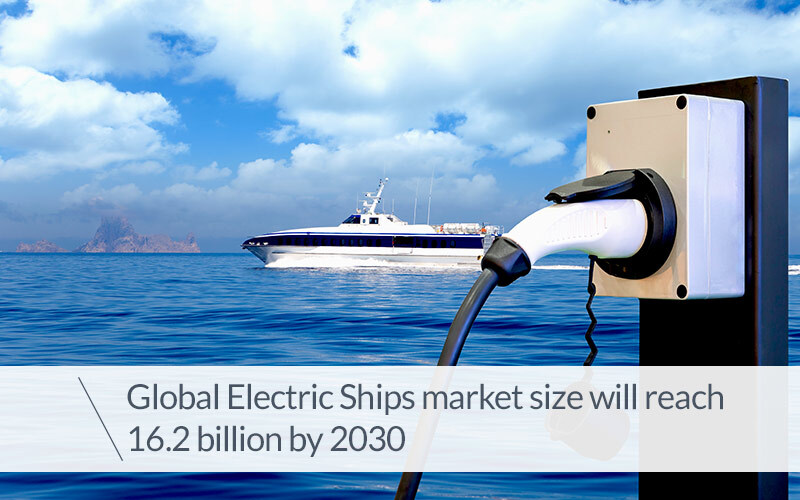
The global electric ships market will grow decisively over the next few years: this is what has emerged from several reports from various institutions, such as MarketsandMarkets™ and Fortune Business Insights.
According to forecasts cited in these reports, the global market for electric ships should increase from 5.5 billion dollars in 2019 to 10.82 billion dollars in 2027, with a CAGR of 11.2% over that same period.
“Electric Ship Market Size & Share | Industry Report, 2021-2030” by MarketsandMarkets™, on the other hand, is based on a different time span, 2021 - 2030, and forecasts the market size to reach 16.2 billion dollars in 2030, with a CAGR of 14.9%.
The highest growth is forecast to be in Europe, which will account for the biggest of the market, also as a direct result of the latest environmental laws. Next, in terms of growth, will be Asia and North America, with notable growth also in Brazil, United Arab Emirates and Saudi Arabia.
Despite differing analytical methods and the set of data available, both reports demonstrate a scenario depicting the growth of the electric ships market, due to a number of important drivers and despite the difficulties created by the pandemic.
Pollutants emitted by ships in circulation
According to Fortune Business Insights, most ships in circulation, including gas and oil carriers, cruise liners, general goods carriers and container ships are still using diesel oil for operations.
Indeed, the world fleet of roughly 90,000 ships uses 370 million tonnes of fuel yearly, producing nearly 20 millions tonnes of sulphur dioxide. Due to increased maritime trade and tourism, it is likely that gaseous output emissions by ships will continue to increase.
Electric propulsion systems are an ecological alternative to conventional fuels used in domestic navigation and for large commercial freighters. Indeed, electric ships are clean, efficient and the cost of battery recharging is much lower compared refilling with heavy fuel oils, especially marine diesel oil.
These factors could promote the adoption of hybrid ships and full electric ships in the near future, with the aim of meeting the parameters defined by the International Maritime Organization (IMO) in June 2021 to reduce emission by maritime trade.
The IMO has intervened in the past, in January 2021, when it required ships to use a low-sulphur fuel, equal to or below 0.5% sulphur content, whereas the previous limit was 3.5% or lower.
The impact of the pandemic on the growth of electric ships
The Covid-19 pandemic blocked growth in this sector, due to delays in the financing of innovative activities programs, which forced original parts manufacturers and investors to adopt more restrictive investment measures.
The pandemic also influenced the supply of essential materials for the propulsion systems of electric ships, thus causing restrictions in the development and a significant increase in prices for raw materials such as lithium, nickel and cobalt.
Technological barriers to take on and overcome
The main reason for difficulties in adopting entirely electrical ships is due to the current battery technology. Even ships which operate across short distances require a huge quantity of energy, and the energetic density of batteries currently deployed is not sufficient to satisfy the energy demand for the large trade ships.
On average, smaller ships have an autonomy of roughly 80 km with a single battery charge, which compared to a ship using combustible fossil fuels, could not be enough to satisfy the final users’ needs.
Furthermore, ship owners need to take on considerable capital costs for various reasons, for example the lack of infrastructure for battery recharges and the high costs of energy storage, since current battery capacity is still limited.
Therefore it is forecast that these factors may hinder market growth.
Hybrid ships
In fuelling terms, the electric ships market can be divided into two sectors; full electric ships and hybrid ships, that is to say, electric ships which also have diesel generators able to recharge the batteries and able to drive the ship when more power is needed or when the batteries are exhausted.
The latter category has dominated the markets until now, permitting the reduction of fuel consumption by nearly 20%, and CO2 emissions by ships by up to 15%. Still, they can allow navigation by completely electrically powered propulsion for a brief time period (for 15 to 30 minutes for large scale vessels).
Over the transition period these hybrid ships will undoubtedly cover an essential role but as one can easily guess, they won’t resolve the issue of climate-altering emissions.
According to Fortune Business Insights, the totally electric ships market segment is destined to grow significantly, due to increased usage of this type of fuel for small passenger ships and ferries which operate on domestic routes.
An example is the very first ferry for vehicles in the world that is 100% electrically fuelled, called “Ampere”, operational in Norway since 2015, which weighs half of a conventional ferry and generates CO2 emissions equal to 5% of a conventional ferry. Operational costs are 80% lower and the ferry saves nearly 1 million litres in diesel fuel per year.
These factors will help stimulate growth, but for medium/long distance trade ships we are still in the early days of this technology.
Nevertheless, the development of marine electrical propulsion technology and alternative fuel sources such as fuel cells, means that there is an enormous opportunity for manufacturers to work on electrical propulsion systems for large-scale vessels.



